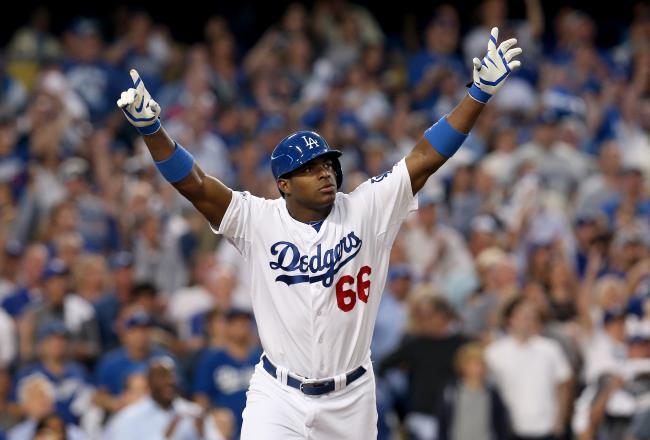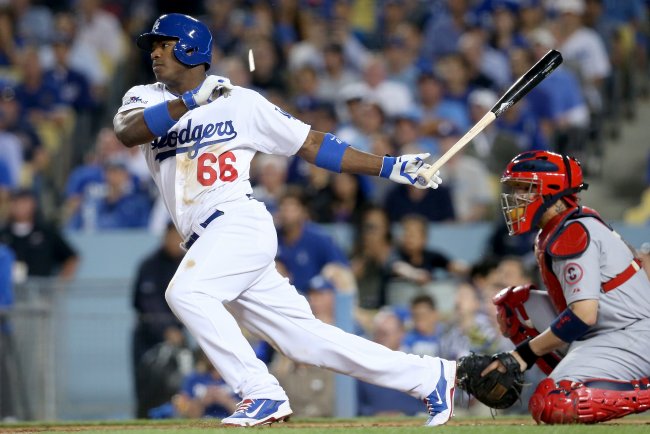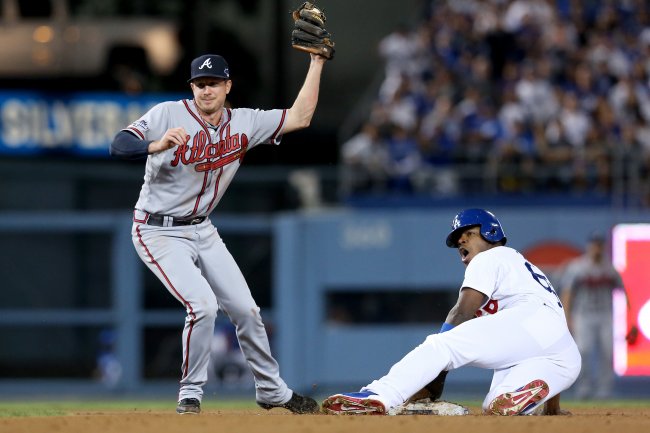
Stephen Dunn/Getty Images
Vin Scully, the legendary announcer of the Los Angeles Dodgers, refers to Yasiel Puig as "the Wild Horse." As far as nicknames go, it was the perfect one for Puig in 2013.
Puig is indeed a powerful, majestic creature. Hence
the "horse." But in his rookie season, he basically lived by his own
rules. Hence the "wild."
But what about in 2014? Will Puig still be a wild horse, or will he be too refined for that nickname to make sense? Will he stay the same, or will he change?
Puig shouldn't want to change too much. When
one hits .319/.391/.534 in one's first full regular season and
.333/.366/.410 in one's first postseason, one should be focused on
keeping things the same more than on undergoing a complete overhaul.
Nonetheless, 2014 Puig should be a different player than 2013 Puig in several different respects—and a different all-around player as a result.
Let's break it down.
Puig at the Plate

Getty Images
If there's one thing that defined Puig's approach at the plate in 2013, it was his aggressiveness.
Puig saw only 3.57 pitches per plate appearance, according to Baseball-Reference.com, a low number by today's standards. One reason for that was Puig's tendency to swing at the first pitch. Whereas the rest of the league swung at the first pitch only 27 percent of the time, Puig swung at the first pitch 43 percent of the time.
Ordinarily, this is finger-wagging time. Swinging at the first
pitch generally isn't the best idea, as the odds of success are usually
in the pitcher's favor. And of all the things batters can do, there's
nothing worse than giving a pitcher an easy one-pitch out.
But some players are special. Puig, as it happens, is very special.
Puig hit .551 with a 1.072 slugging percentage when he swung at the first pitch in 2013. Per Baseball-Reference.com, his 1.642 OPS when swinging at the first pitch was the best in the league.
The amazing part is that it's not like he was just crushing first-pitch fastballs. He was crushing first-pitch everythings, as these numbers from Brooks Baseball can vouch:
| Pitch Type | Count | AB | AVG | ISO | HR |
| Fourseam | 116 | 12 | 0.667 | 0.750 | 2 |
| Sinker | 120 | 19 | 0.368 | 0.211 | 1 |
| Change | 31 | 6 | 0.333 | 0.667 | 1 |
| Slider | 84 | 22 | 0.682 | 0.773 | 5 |
| Curve | 48 | 3 | 1.000 | 0.667 | 0 |
| Cutter | 25 | 6 | 0.333 | 0.000 | 0 |
| Split | 3 | 1 | 1.000 | 0.000 | 0 |
Brooks Baseball
If Puig was only crushing first-pitch fastballs, the writing on the wall would be instructing pitchers to pitch Puig backwards. For Puig, that would mean spending the winter preparing for that to happen.
But since this isn't the case, don't be surprised when Puig
continues his habit of being a first-pitch hacker in 2014. He's proven
he can be monstrously successful at it against all types of pitches, so
more power to him.
Courtesy of MLB Advanced Media via MLB.com.
One offseason project Puig should be interested in, however, is preparing for Uncle Charles.
You can see in the above table that Puig did
fine against first-pitch sliders, and that's part of a larger trend. He
hit sliders to the tune of a .323 average and a .333 ISO, clubbing 10 of
his 19 homers against sliders. Eight of those came against right-handed
pitchers, meaning he was dangerous against a pitch that might be the
biggest weapon for right-handed pitchers against right-handed batters.
But curveballs? Puig liked those about as much as Pedro Cerrano.
If you look up Puig's pitch values on FanGraphs, one thing you notice is that he generated exactly zero runs above average against curveballs
in 2013. And if we use Brooks Baseball to take a closer look, we notice
that he was particularly out of his league against two-strike curves:
| Split | Seen | Swing % | Whiff/Swing % | HR | BABIP |
| Overall | 146 | 43.84 | 39.06 | 1 | .316 |
| Two-Strike Counts | 45 | 64.44 | 41.38 | 0 | .125 |
Brooks Baseball
Puig did a good job of laying off curveballs
in most counts, but not with two strikes. It's therefore not good that
he wasn't able to make contact with them as well as he did in other
counts and not the least bit surprising that he wasn't able to do
anything with the ones he did make contact with.
This, mind you, is but a primary symptom of a larger problem: Puig was not a good two-strike hitter in his rookie season.
Puig had just a .509 OPS in two-strike counts, according to Baseball-Reference.com. The league average was .514, so Puig wasn't even average when he had two strikes on him.
Part of the problem was that Puig was predictable. As his zone profile over at Brooks Baseball can show, pitchers loved to throw Puig breaking and off-speed junk off the outside corner, and he couldn't do anything with these pitches when he decided to swing.
If there's a bright side, however, it's that Puig did a better job laying off this junk in August and September than he did in June and July.
That he was able to make a midseason adjustment to what the
scouting reports were telling pitchers to do suggests pretty clearly
that the Wild Horse isn't a brainless horse. Ben Lindbergh of Baseball Prospectus noticed as much in early August when he noted that Puig had begun to adjust to adjustments pitchers had begun making to him, and this is a case where the numbers fit the narrative.
Courtesy of MLB Advanced Media via MLB.com.
In Puig's debut month of June, he had a 1.180 OPS. In
July, his OPS regressed to .789, and he struck out in nearly 30 percent
of his plate appearance. But then in his next 49 games, Puig
posted an .897 OPS and struck out in only about 20 percent of his plate
appearances. That covers the period when he was better at laying off
the junk pitchers were throwing him off the outside corner with two
strikes.
So in looking forward to Puig's hitting in 2013, you can expect to see one thing stay the same and a couple things change.
The thing that will stay the same is Puig's aggressiveness, particularly on the first pitch. It worked for Puig
because he proved capable of hitting all sorts of first pitches. Since
pitching backwards isn't a clear option, pitchers don't have a clear
avenue to pursue in this case. That works in Puig's favor.
As for what will change, expect Puig to fare better against curveballs. That's an area where simple experience could help the most, as Mike Trout told me recently that having a year in the big leagues "definitely" helped him improve his own production against curveballs in his second season.
Then there's Puig's two-strike approach. The latter
end of the regular season saw him adjust to what pitchers liked to do
with him in two-strike counts. If he's smart—and he's indicated that he is—he'll continue to work on the adjustment he made and become a better two-strike hitter.
It's a bit much to expect Puig to win a
batting title or lead the league in on-base percentage in 2014, as he's
not going to be able to go from being the Wild Horse to being Joey Votto or Miguel Cabrera in one offseason. He's also due for a BABIP regression after posting a .383 BABIP in 2013.
But after achieving a .925 OPS on raw talent in 2013,
an OPS in that same neighborhood in 2014 is fair game if he does what
must be done.
That takes care of what Puig has to do at the plate. Goodness knows, however, that the plate isn't the only area of concern with him.
Puig in the Field
If you buy into the defensive metrics, Puig was a very good defensive outfielder as a rookie.
Per FanGraphs, Puig posted a 9.7 UZR/150 in 2013. Among right fielders with at least 700 innings in the field, that was good for sixth in between Jay Bruce and Jose Bautista.
Fielding Bible metrics also approved of Puig's defense. He tallied 10 defensive runs saved (DRS) in 2013, good for seventh among right fielders.
We just don't tend to think of Puig as a very good
outfielder, however, because...Well, because of stuff like what happened
in Game 6 of the National League Championship Series:
Courtesy of MLB Advanced Media via MLB.com.
That's some lowlight reel. It contains a halfhearted
throw that had no chance of getting the runner at home and allowed a
runner to advance, another poor throw that went way over the catcher's
head and allowed two runners to advance and a misplay that resulted in a
runner going to second when first might have been the extent of his
journey.
That last misplay was Puig's second such misplay in as many games, as he also turned what could have been an out off the bat of Matt Holliday into a double in Game 5.
It's plays like these that drove all of us crazy when watching Puig, and they did indeed happen too often.
The good news, however, is that Puig's throwing problem is really a "problem," per se. It's merely something that can be improved.
It's not a problem because Puig's arm did more good
than harm in 2013. He tallied eight outfield assists, and he saved more
runs above average with his arm than all but five other right fielders.
That's as good an indication that Puig shouldn't want
to completely overhaul his approach to throwing, as his arm strength is a
weapon that's going to come in handy a lot over a full season.
However, Puig must get better about picking his spots.
Poor decisions with his throwing did cost the Dodgers on occasion in
2013. Poor decisions are likely to bite the Dodgers even more in 2014,
as the scouting report on Puig's arm being out is likely to result in fewer baserunners giving him a chance to unleash his arm. Him nabbing baserunners will have to be the result of smart thinking more so than sheer arm strength.
Courtesy of MLB Advanced Media via MLB.com.
Assuming he's willing to respond to their efforts, this is an area where the Dodgers can help Puig.
They can work with him on being better about reading situations as
they're unfolding, which in turn will give him a better understanding of
when to unleash his arm and when to holster it.
How exactly will Puig get better with his throwing?
Look at it this way: Since his M.O. in 2013 was basically to be
aggressive with his throwing 100 percent of the time, the only way to go
is up.
Where things are less hopeful is in the department of misplays. For unlike with his throwing, there was no way Puig could do more good than harm when it came to misplays.
Puig officially made three fielding errors all season, but these played a part in him finishing third from the bottom
among right fielders in error runs above average. That's bearing in
mind that not every single one of his misplays was charged as an error.
The Holliday double is a good example.
There's not much the Dodgers can do to help Puig in this regard. Helping him with throwing plays is basically a matter of them peddling fundamentals. Puig's tendency for misplays is more about focus.
The Dodgers can't teach him to be focused. It's an effort only Puig can make, and he has to want to make it.
There's, admittedly, not a whole lot of projection that can be done with Puig's
defense. But if he responds to efforts to refine his throwing habits
and takes it upon himself to be focused 100 percent of the time in the
field, an already very good outfielder is going to become a great
outfielder.
With hitting and defense covered, that just leaves baserunning.
Puig on the Bases
Whether Puig was an effective baserunner in 2013 varies depending on who you ask.
If you ask FanGraphs, he wasn't. In the eyes of their metrics, Puig logged minus-4.2 baserunning runs above average in 2013, making him one of the worst baserunning outfielders in the league.
But if you ask Baseball Prospectus, Puig was pretty good on the basepaths.
By BP's metrics, Puig accounted for 0.8 baserunning
runs (BRR), technically making him an above-average baserunner. The
only area where he did more harm than good was in stolen bases.
And it's easy to see why.

Getty Images
Puig did steal 11 bases in 2013, but he also got
caught eight times. That's not a good success rate, and it obviously
speaks to recklessness.
Consider this anecdote from MLB.com's Richard Justice about a July game against the San Francisco Giants:
For instance, on Sunday afternoon, he singled against the Giants and promptly stole second. And then almost without a thought -- actually with no thought at all -- he was thrown out attempting to steal third.'I could smell it in the air,' Vin Scully said. 'The wild horse wanted to run.'
That was one of two times Puig was caught stealing third in 2013. He was successful once.
There's also the matter of the pickoffs. Puig was picked off four times in 2013, including twice while trying to steal. That's a few too many.
Puig has to pick his spots better with stolen bases,
which is yet another project the Dodgers can help him with. And if he
really wants to make a name for himself as a base stealer, he needs to
take the time to study pitchers so he has more than just his athleticism
to rely on.
Or, Puig could just decide to take it easy on stealing bases and stick to being a specialist at taking extra bases.
This is something Puig is already good at. He went first to third 12 of the 26 times he was standing on first base when a single was hit. All told, Baseball-Reference.com says he took an extra base or two over half the time he had a chance on base hits. BP's metrics say that the only Dodger better than Puig at turning baserunning plays on hits into runs was Carl Crawford.
Like with his fielding, this is an area where it's hard to project how Puig
is going to be different in 2014. But he can certainly be a better base
stealer if he makes the needed effort to be one, and all he has to do
to be a productive baserunner otherwise is just keep doing what he's
doing.
So All Told...
It's going to be a shocker if Puig ends up being the same player in 2014 that he was in 2013. There should be changes, and these changes should be for the better.
Puig is one of the rare ones who can make a
hyper-aggressive approach at the plate work, but 2014 should see him be
less overmatched against curveballs and in two-strike
counts. It's hard to project a massive improvement in his production,
but sharpening up his hitting habits should at least help him stave off a
regression.
What will Yasiel Puig be in 2014?
Submit Vote vote to see results
A better player
71.7%About the same
15.1%A worse player
13.2%
What will Yasiel Puig be in 2014?
As for defense and baserunning, Puig
improving in those two areas will depend on him working with the Dodgers
in adding a method to his madness. Because there basically was no
method to his madness in 2013, it's perfectly fair to expect him to get
better in these two areas rather than worse.
In all, Puig should be a better all-around player in
2014 than he was in 2013. That might come off as being overly
optimistic, but it must be kept in mind that there are some unusual
circumstances at work here.
Puig didn't get to play baseball in Cuba during the
2011-2012 season due to disciplinary reasons. After he defected, he only
got to play 23 minor league games in the Dodgers organization at the
end of 2012. With his age-21 season basically wiped out, Puig
arrived in the major leagues as a highly inexperienced 22-year-old.
It's only natural that his inexperience humbled him on numerous
occasions.
It was Puig's talent that made him a star. And while
his 2013 season may have been a rocky road that had a particularly rocky
end, it did serve to arm him with some much-needed experience.
As 2013 Puig showed, talent is good. What 2014 Puig should show is that talent plus experience is even better.
Note: Stats courtesy of Baseball-Reference.com unless otherwise noted.
No hay comentarios:
Publicar un comentario